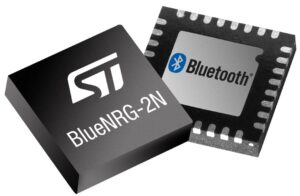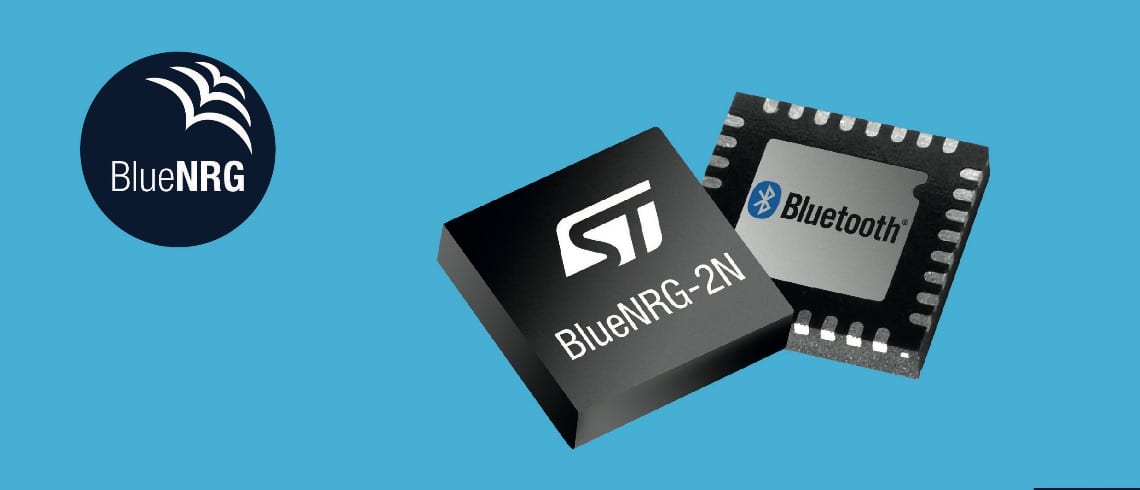To improve the accessibility of our content, please find the audio version of this blog post.
Read our article on the BlueNRG-2 to better understand the network processor of the BlueNRG-2N.
We are launching BlueNRG-2N, our first Bluetooth 5 network processor. Unlike the BlueNRG-2 System-on-Chip (SoC), this network processor doesn’t offer the use of a microcontroller to the user. Previously the only ST Bluetooth network processor was the Bluetooth 4.2 BlueNRG-MS. We featured it in many blog posts. In the PlacePod paper, the device helped update the firmware of a parking detection system. In the Snuza Pico, it paired with a smartphone to send data or an alert in the event of distress. The BlueNRG-2N now acts as its successor, opening the door to more powerful applications running in low-power systems.
ST offers Bluetooth SoCs like the BlueNRG-2 because the microcontroller inside can serve as the primary host. Or developers need the MCU for a piece of their overall application. For instance, the Nextent Tag fits its entire contact tracing and physical distancing app into the BlueNRG-2’s Cortex-M0. However, when engineers needed an external MCU but were also very power-conscious, they would choose the BlueNRG-MS processor. The problem arose when they would require a processor that would support Bluetooth 5. The BlueNRG-2N solves that issue while also redefining the accessibility, the security, and the efficiency of our Bluetooth platform.
BlueNRG-2N: A More Accessible Platform Thanks to a Pre-Programmed Firmware Image

Feature-wise, the new BlueNRG-2N, and the BlueNRG-2 are identical. Developers can thus enjoy a wide range of functionalities in a module that consumes only 6.2 mA at -2 dBm. And to help teams wishing to experiment with the BlueNRG-2N as soon as possible, we released a special firmware. Engineers can flash the STSW-BNRG2N-V320 onto an existing BlueNRG-2 and use it as a BlueNRG-2N. It’s thus the quickest way to start a proof-of-concept with the new device.
Traditionally, once teams start to work on their custom design, they inevitably have to program their BlueNRG-2. As a result, we have an SDK and other tools to help them. Nonetheless, we decided to go one step further with the release of our latest network coprocessor. Indeed, the BlueNRG-2N will come pre-programmed by ST with a certified image. Hence, developers will not need to program it, thus reducing their time to market. Additionally, hackers won’t be able to run a different microcode. Securing the Bluetooth module thus became vastly more straightforward and more thorough.
BlueNRG-2N: A More Efficient Platform Thanks to Data Length Extension for Faster Firmware Updates
As we saw in the PlacePod case study, companies used the BlueNRG-MS to update their system’s firmware. However, such a process can take a lot of time. After all, Bluetooth 4.2 didn’t primarily target this use case. However, ST can bring a solution to this issue with the BlueNRG-2N. Since our latest device offers the same features as the BlueNRG-2, the new Bluetooth coprocessor supports Data Length Extension. Overall, the functionality will enable 2.5 times faster firmware upgrades (up to 700 kbps) compared to a system running on BlueNRG-MS.
Data Length Extension allows the creation of a much larger Data Channel Protocol Data Unit (PDU) Payload. At the heart of every telecommunication protocol, the PDU represents a unit that the system transmits to another module. On Bluetooth, the PDU’s Payload is traditionally 27 bytes with ATT Data accounting for 20 bytes. With DLE, developers can use a PDU Payload of up to 251 bytes because the ATT Data part can now hold 244 bytes. Transmitting more data at once makes updating a firmware over-the-air much faster and more reliable.
BlueNRG-2N: A More Secure Platform Thanks to LE Privacy 1.2 and Randomized MAC Addresses
Another everyday use case for the BlueNRG-MS was to pair it with a smartphone or smart device. Once two products pair and trust each other, they advertise to one another to reconnect. For instance, after powering a smart speaker back on, the product will advertise to a smartphone, hoping to establish a connection. During this process, a Bluetooth device sends its MAC address. Unfortunately, this can be a potential security threat if hackers are snooping. Since BlueNRG-2N draws from BlueNRG-2, developers can enjoy privacy features that weren’t present on the BlueNRG-MS. For instance, teams now have access to LE Privacy measures.
If developers use LE privacy, the advertising radio will send a reconnection address, a random MAC address. Once the trusted device receives it, it can use a cryptographic key from the trusted module to get the real MAC address out of the reconnection one. Moreover, BlueNRG-2N, just like BlueNRG-2, supports LE Privacy 1.2. This functionality allows the module to randomize the address using a timer. As a result, the network processor generates a new random address more often, thus giving developers more control. Furthermore, decrypting the reconnection address can also occur in the controller instead of the host MCU. Moving the computation to the controller thus saves energy and time.
